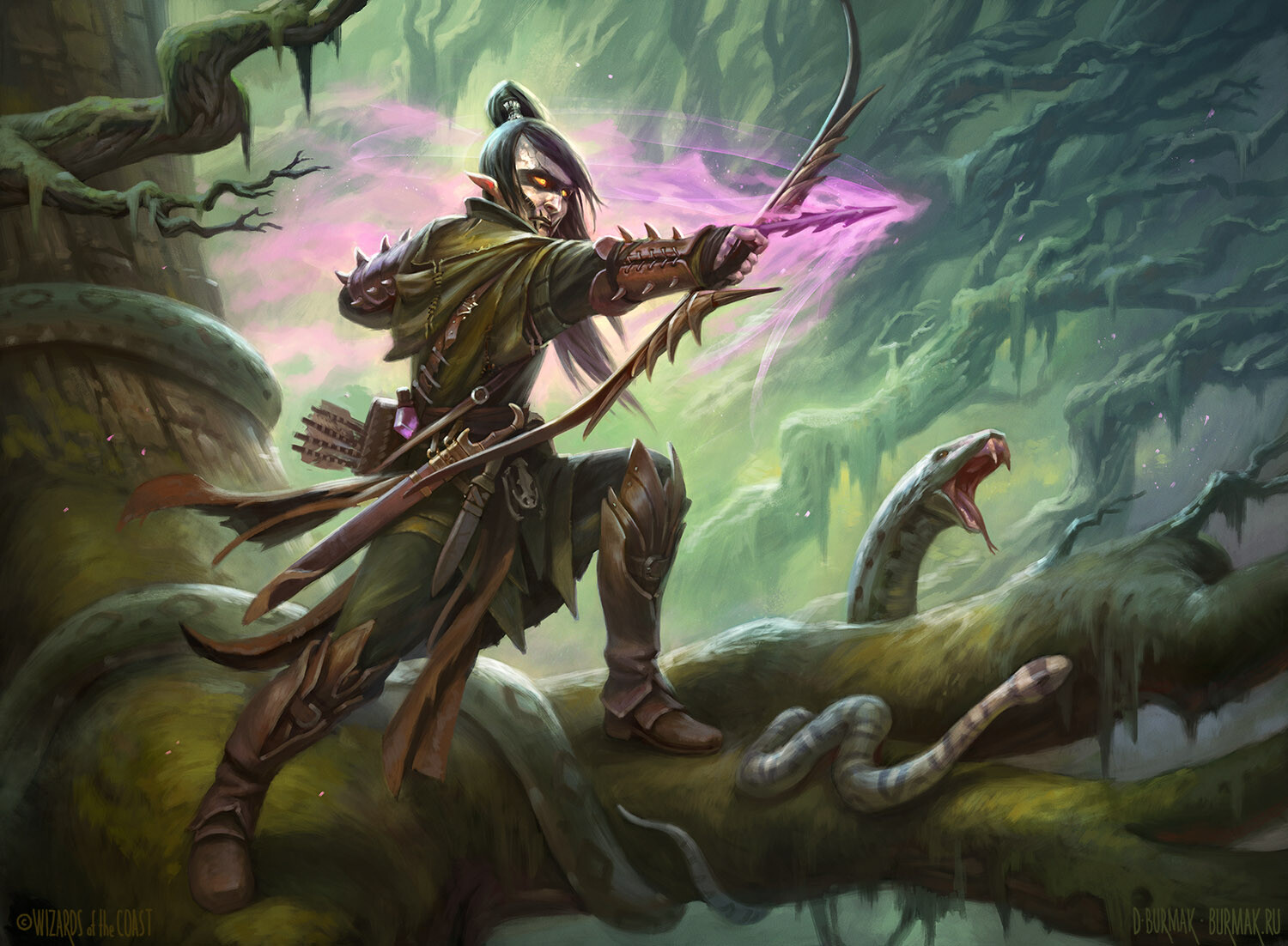Poisoner 5e
Published on March 12, 2022, Last modified on September 28th, 2023
If you want to feel like the Witcher, using oils on your blades to get the upper hand in combat, the Poisoner feat may be right for you.

Dmitry Burmak - Wizards of the Coast - Poison-Tip Archer
Arcane Eye may earn a small commission from affiliate links in this article.
Learn more.What Is Poisoner 5e?
Tasha’s Cauldron of Everything brought a slew of feats that allow players to specialize their characters and customize them more than ever before.
One of the ways that you can make your character ooze with flavor is by picking up the Poisoner feat, which allows you to add a little ‘spice’ to your life, and to the death of your enemies.
How Does Poisoner Work?
- You can coat a weapon with poison as a bonus action instead of a regular action.
- Whenever you make a damage roll, you ignore any poison resistance that your target has.
- You also gain proficiency with the poisoner’s kit. You can spend an hour and 50gp using this kit to make potent poison doses equal to your proficiency bonus. Once applied to a weapon or ammo, this poison stays potent for one minute or until it hits something. If this weapon or ammo hits a creature, it must make a DC 14 CON save or take 2d8 poison damage and become poisoned.
Is Poisoner Good?
In our 5e Feats Tier List, Poisoner was given a B Tier rating, making it a niche feat that can improve some builds in D&D 5e.
An extra 2d8 poison damage is an excellent buff to martial characters who don’t have a solid use for their bonus action. The cost of 50gp really isn’t that much for characters who have spent a decent time adventuring and being able to create doses equal to your proficiency bonus is solid value for money.
Crafting has never been a large focus in 5e and this feat is a good start. When it comes to using poison in combat, ignoring poison resistance isn’t nearly as helpful as ignoring poison immunity would be, but being able to apply the poison to a weapon as a bonus action, rather than an action helps with the feat’s viability.
One thing to note is this feat also provides the ability to make poison at a much faster rate than ever before. For reference, in the PHB, it states that it would take 20 days to craft a single vial of basic poison. In comparison, this feat allows you to create your proficiency bonus worth of vials in an hour.
Unfortunately, this feat has a couple extremely limiting factors that impact its viability. First, the poison only lasts for a minute once applied to a weapon, which means it pretty much has be exclusively used in combat. Second and much more of an issue is the DC for the CON saving throw is quite low and doesn’t doesn’t even do half damage on a successful save.
Poisoner 5e Interactions
The Poisoner feat may mention the Poisoned condition, but you’ll need to look deeper into the Player’s Handbook to find the actual status effect.
A poisoned creature has disadvantage on all attack rolls and ability checks. Inflicting poison on tough foe is really good in a combat situation, but it can also make a difference in non-combat scenarios. You really don’t want to be Poisoned if you need to make a series of difficult climbing or swimming checks out in the dangerous wilderness.
Which 5e Classes Make the Most of Poisoner?
The color code below has been implemented to help you identify, at a glance, how good the Poisoner 5e feat is for a specific class/subclass.
- Red isn’t going to contribute to the effectiveness of your character build at all
- Orange Situationally good, but a below-average option otherwise
- Green is a good option
- Blue is a great option, you should strongly consider this option for your character
- Sky Blue is an amazing option. If you do not take this option your character would not be optimized
Poisoner is best on builds that:
- Are lacking a reliable method of crowd control or ways to inflict status effects.
- Have access to good poison damage, whether it’s through spells or weapons.
- Want to roleplay as an assassin.
- Want something to do in their downtime and have gold to spare.
- Are martial builds that used ranged and melee weapons.
- Don’t have a great use for their bonus action, as the poison takes a bonus action to apply.
Artificer: This feat works well with the artificer's tinkering nature and synergizes really well for the Alchemist subclass. Even if your artificer won't be using the poison in combat, you could always give it to your martial party members.
Barbarian: Once raging, barbarians don't have much use for their bonus action outside of two-weapon fighting. Having access to an extra 2d8 poison damage on your attacks is a great way to stretch your damage and the poisoned condition is an excellent debuff. Unfortunately, the low DC for the save makes this less impactful the higher level you get.
Bard: Some bards who want to lean into a rogue archetype might like this. However, they will only benefit from poisoning weapons and ammo, as they don’t know any poison spells innately. The biggest factor that gets in the way of melee bard's use of Poisoner is Bardic Inspiration, which also takes a bonus action and can be more impactful than effect of this feat.
Cleric: Clerics should be skipping this feat entirely. Melee clerics have better feats to pick up, and supporting clerics would rather use their damaging cantrips or buffs.
Druid: No druid wants this feat. It doesn’t work for spellcasting druids because they only have access to one poison cantrip, and melee druids are usually in Wild Shape.
Fighter: Fighters don't have much use for their bonus action outside of two-weapon fighting. Having access to an extra 2d8 poison damage on your attacks is a great way to stretch your damage and the poisoned condition is an excellent debuff. Unfortunately, the low DC for the save makes this less impactful the higher level you get. Obviously, something like Great Weapon Master or Polearm Master would be much stronger, but this can be fun, especially in the lower levels.
Monk: Monks won’t benefit from this at all, outside of flavor. Also, they can’t wipe poison on their hands
Paladin: Skip. Paladins have too many other resources, like smites and spells, that will take up their bonus actions. Plus, there are a plethora of better feats for them to choose from that synergize with their gameplay.
Ranger: Rangers who want to act like rogues can pick this up. Since it works for melee and ranged, it blends well with the ranger hybrid style. Obviously, this will compete with hunter's mark for your bonus action slot. But, once hunter's mark is set up, it can be a valuable source of extra damage and debuff.
Rogue: This is the best way to get reliable access to poisons, something that any assassin-type character would like to have. This feat also allows you to make much cheaper and more effective poisons than other poisons you might find in the world. While the feat does ignore resistance to poison, there are many creatures that are simply immune to poison, rendering poison one of the worse damage types in 5e. In addition, a DC 14 CON save is overcome quite easily, especially at higher levels. The bonus action to apply the poison may also conflict with your Cunning Action.
Overall, this is a cool synergy for rogues, but won't be the most impactful feat.
Sorcerer: Nothing in the sorcerer kit would make this feat worth getting at all. They get a few poison spells, but they aren’t as good as their other spells.
Warlock: Nothing in the warlock subclasses meshes well. Hexblades who don’t want to multiclass to paladin for a smite can use this, but that's the best use case.
Wizard: Most wizards should skip this feat. They do get access to the most poison spells available, but none of the subclasses offer any synergy.
Poisoner 5e FAQs
How can you make poison in 5e?
Per the original rules, each day of downtime you spend crafting only allows you to create a total value of 5gp. This means if you were to make a basic poison would cost you 20 full days of nothing but crafting and 50gp (because the crafting cost is half market value). With this feat, the ability to make poison is incredibly cheaper, and not to mention faster. You should also speak to your dungeon master about learning to craft more potent poisons as the game goes on.
Conclusion
Poison-makers are iconic in fantasy settings like D&D, and the poisoner feat is no different. This feat is dripping with flavor, but that’s it. Min-maxers won’t like this feat, and most classes won’t benefit from it, but it does add a lot of personality to a character.
What are your thoughts on the Poisoner feat in 5e? Do you wish it did more or added more poisons to make? Let us know how you feel in the comments.
Fill out the form below to receive Escape From Mt. Balefor for free!
Or follow us on Instagram, Twitter, and YouTube.

